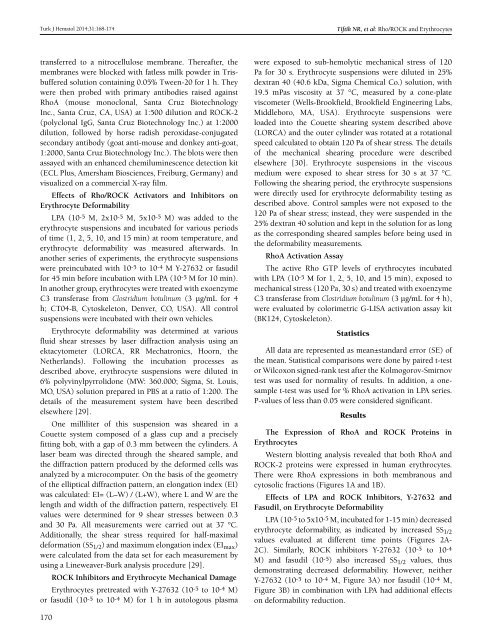Turkish Journal of Hematology Volume: 31 - Issue: 2
Create successful ePaper yourself
Turn your PDF publications into a flip-book with our unique Google optimized e-Paper software.
Turk J Hematol 2014;<strong>31</strong>:168-174<br />
Tiftik NR, et al: Rho/ROCK and Erythrocytes<br />
transferred to a nitrocellulose membrane. Thereafter, the<br />
membranes were blocked with fatless milk powder in Trisbuffered<br />
solution containing 0.05% Tween-20 for 1 h. They<br />
were then probed with primary antibodies raised against<br />
RhoA (mouse monoclonal, Santa Cruz Biotechnology<br />
Inc., Santa Cruz, CA, USA) at 1:500 dilution and ROCK-2<br />
(polyclonal IgG, Santa Cruz Biotechnology Inc.) at 1:2000<br />
dilution, followed by horse radish peroxidase-conjugated<br />
secondary antibody (goat anti-mouse and donkey anti-goat,<br />
1:2000, Santa Cruz Biotechnology Inc.). The blots were then<br />
assayed with an enhanced chemiluminescence detection kit<br />
(ECL Plus, Amersham Biosciences, Freiburg, Germany) and<br />
visualized on a commercial X-ray film.<br />
Effects <strong>of</strong> Rho/ROCK Activators and Inhibitors on<br />
Erythrocyte Deformability<br />
LPA (10-5 M, 2x10 -5 M, 5x10 -5 M) was added to the<br />
erythrocyte suspensions and incubated for various periods<br />
<strong>of</strong> time (1, 2, 5, 10, and 15 min) at room temperature, and<br />
erythrocyte deformability was measured afterwards. In<br />
another series <strong>of</strong> experiments, the erythrocyte suspensions<br />
were preincubated with 10 -5 to 10 -4 M Y-27632 or fasudil<br />
for 45 min before incubation with LPA (10 -5 M for 10 min).<br />
In another group, erythrocytes were treated with exoenzyme<br />
C3 transferase from Clostridium botulinum (3 µg/mL for 4<br />
h; CT04-B, Cytoskeleton, Denver, CO, USA). All control<br />
suspensions were incubated with their own vehicles.<br />
Erythrocyte deformability was determined at various<br />
fluid shear stresses by laser diffraction analysis using an<br />
ektacytometer (LORCA, RR Mechatronics, Hoorn, the<br />
Netherlands). Following the incubation processes as<br />
described above, erythrocyte suspensions were diluted in<br />
6% polyvinylpyrrolidone (MW: 360.000; Sigma, St. Louis,<br />
MO, USA) solution prepared in PBS at a ratio <strong>of</strong> 1:200. The<br />
details <strong>of</strong> the measurement system have been described<br />
elsewhere [29].<br />
One milliliter <strong>of</strong> this suspension was sheared in a<br />
Couette system composed <strong>of</strong> a glass cup and a precisely<br />
fitting bob, with a gap <strong>of</strong> 0.3 mm between the cylinders. A<br />
laser beam was directed through the sheared sample, and<br />
the diffraction pattern produced by the deformed cells was<br />
analyzed by a microcomputer. On the basis <strong>of</strong> the geometry<br />
<strong>of</strong> the elliptical diffraction pattern, an elongation index (EI)<br />
was calculated: EI= (L–W) / (L+W), where L and W are the<br />
length and width <strong>of</strong> the diffraction pattern, respectively. EI<br />
values were determined for 9 shear stresses between 0.3<br />
and 30 Pa. All measurements were carried out at 37 °C.<br />
Additionally, the shear stress required for half-maximal<br />
deformation (SS 1/2 ) and maximum elongation index (EI max )<br />
were calculated from the data set for each measurement by<br />
using a Lineweaver-Burk analysis procedure [29].<br />
ROCK Inhibitors and Erythrocyte Mechanical Damage<br />
Erythrocytes pretreated with Y-27632 (10-5 to 10 -4 M)<br />
or fasudil (10 -5 to 10 -4 M) for 1 h in autologous plasma<br />
were exposed to sub-hemolytic mechanical stress <strong>of</strong> 120<br />
Pa for 30 s. Erythrocyte suspensions were diluted in 25%<br />
dextran 40 (40.6 kDa, Sigma Chemical Co.) solution, with<br />
19.5 mPas viscosity at 37 °C, measured by a cone-plate<br />
viscometer (Wells-Brookfield, Brookfield Engineering Labs,<br />
Middleboro, MA, USA). Erythrocyte suspensions were<br />
loaded into the Couette shearing system described above<br />
(LORCA) and the outer cylinder was rotated at a rotational<br />
speed calculated to obtain 120 Pa <strong>of</strong> shear stress. The details<br />
<strong>of</strong> the mechanical shearing procedure were described<br />
elsewhere [30]. Erythrocyte suspensions in the viscous<br />
medium were exposed to shear stress for 30 s at 37 °C.<br />
Following the shearing period, the erythrocyte suspensions<br />
were directly used for erythrocyte deformability testing as<br />
described above. Control samples were not exposed to the<br />
120 Pa <strong>of</strong> shear stress; instead, they were suspended in the<br />
25% dextran 40 solution and kept in the solution for as long<br />
as the corresponding sheared samples before being used in<br />
the deformability measurements.<br />
RhoA Activation Assay<br />
The active Rho GTP levels <strong>of</strong> erythrocytes incubated<br />
with LPA (10-5 M for 1, 2, 5, 10, and 15 min), exposed to<br />
mechanical stress (120 Pa, 30 s) and treated with exoenzyme<br />
C3 transferase from Clostridium botulinum (3 µg/mL for 4 h),<br />
were evaluated by colorimetric G-LISA activation assay kit<br />
(BK124, Cytoskeleton).<br />
Statistics<br />
All data are represented as mean±standard error (SE) <strong>of</strong><br />
the mean. Statistical comparisons were done by paired t-test<br />
or Wilcoxon signed-rank test after the Kolmogorov-Smirnov<br />
test was used for normality <strong>of</strong> results. In addition, a onesample<br />
t-test was used for % RhoA activation in LPA series.<br />
P-values <strong>of</strong> less than 0.05 were considered significant.<br />
Results<br />
The Expression <strong>of</strong> RhoA and ROCK Proteins in<br />
Erythrocytes<br />
Western blotting analysis revealed that both RhoA and<br />
ROCK-2 proteins were expressed in human erythrocytes.<br />
There were RhoA expressions in both membranous and<br />
cytosolic fractions (Figures 1A and 1B).<br />
Effects <strong>of</strong> LPA and ROCK Inhibitors, Y-27632 and<br />
Fasudil, on Erythrocyte Deformability<br />
LPA (10-5 to 5x10 -5 M, incubated for 1-15 min) decreased<br />
erythrocyte deformability, as indicated by increased SS 1/2<br />
values evaluated at different time points (Figures 2A-<br />
2C). Similarly, ROCK inhibitors Y-27632 (10 -5 to 10 -4<br />
M) and fasudil (10 -5 ) also increased SS 1/2 values, thus<br />
demonstrating decreased deformability. However, neither<br />
Y-27632 (10 -5 to 10 -4 M, Figure 3A) nor fasudil (10 -4 M,<br />
Figure 3B) in combination with LPA had additional effects<br />
on deformability reduction.<br />
170

















